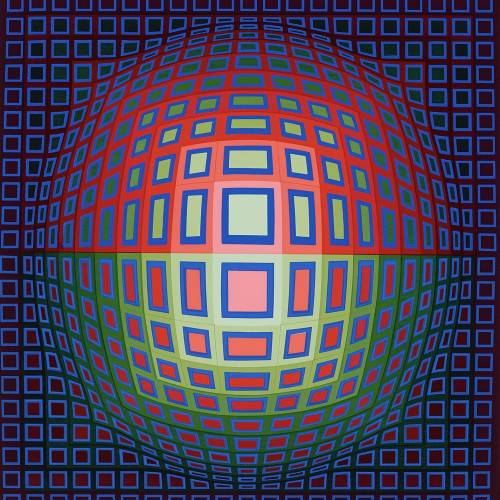Kinetic Zebras and Optical Lines: The Night Skies of Victor Vasarely's Spacetime

By Andrew Bay, UK
Victor Vasarely was born in Hungary in 1906, and spent his childhood in the city of Pecs, on the border of Croatia. Although he was a dedicated student, Vasarely decided to leave medical school at end of his second year, in 1927, to study art at the Podoloni Volkmann Academy in Budapest. He easily found kindred spirits in the bohemian intellectual community of the capital city, and took part in animated conversations about art, philosophy and politics, with like-minded, creative, avant-garde artists and thinkers. One of them was Sandor Bortnyik, who was the director of the Muhely Academy, the centre of the Bauhaus Movement in Budapest.
The Bauhaus School was a German artistic movement founded by the architect Walter Gropius in the 1920s. The ethos of the movement was that all artistic disciplines, from fine arts to crafts, should aim for a cohesive aesthetic unity, based on the elementary Platonic geometric forms: the cube, the rectangle, the square and the circle. These informal principles, would prove to have considerable influence on Vasarely's style, later on in his career.
In 1930, Vasarely decided to move to Paris, with his fellow art student and future wife Claire Spinner, to pursue his career as a painter. Their two sons, Andre and Jean Pierre (who later became a famous painter in his own right, under the name Yvaral) were born in Paris, and Vasarely started working in the advertising industry to support his family. He was determined however to pursue his artistic ambitions, and spent evenings and weekends, tirelessly perfecting his own style.
In 1939, Vasarely met the gallerist Denise Rene, who would prove to be one of his most important collaborators. When she opened the Denise Rene Gallery in Paris in 1944, just as the city was being liberated from German occupation, she asked Vasarely to be the featured artist for her first exhibition. The show was a resounding success, and Vasarely was now free to dedicate himself solely to the pursuit of his art. He started to take great interest in the works of the painters of the Geometric Abstraction School, such as Piet Mondrian, Augustin Herbin and Kazimir Malevich.
Although he felt he had not quite found his own voice yet , he meticulously studied the geometric abstractionists works, and became proficient with optical effects techniques, through the use of controlled colour compositions, and permutations of polychromatic surfaces and shapes.
Vasarely's work went through a major transformation around 1947. By his own admission, he started to feel that he could recognise the geometric patterns inherent in Nature, and made a thoroughgoing shift from representational symbolic paintings, to strictly geometric structures based works. Vasarely had effectively found his own unique voice, with these distinct, abstract, highly stylised images.
Starting with his "Homage To Malevich" series painted from 1952 to 1958, Vasarely adopted a systematic approach to constructing sprightly black-and-white kinetic pictures. Subsequent experimental developments in that direction, graphically led Vasarely to produce the visual tricks and illusions, which we now commonly refer to as Op Art, as in Optical Art. In classic pieces such as "Vega" (1957) and "Cassiopee II" (1958), our eyes are presented with diagonal fields, interspersed with horizontal and vertical spatial depth. The paintings expand and refract on various scales, thus expressing the bolstering infinite nature of the Universe.
Overall, Vasarely's work is a reaction to contemporary modern technology. Most of his ideas originate from his keen interest in abstract mathematical conjectures and scientific hypotheses; he always thought of his art as visually consonant with theoretical physics, dynamically exploring the concepts of space and time, matter and energy. In this regard, Vasarely undoubtedly was also a major influence on the Kinetic Art movement, from its inception. With his vital compositions oscillating from monochromatic fusions to beautiful whirlpools of colour, Vasarely laid the definitive understructure for the Op and Kinetic Art movements, alongside famous alumni Bridget Riley and Yaacov Agam.



















